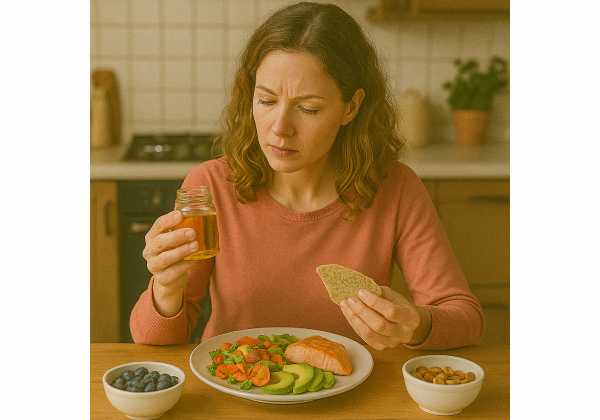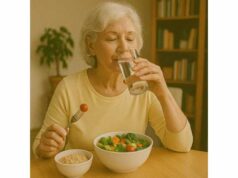
Longevity is not only about adding years; it is about adding more years you can enjoy. One way to do that is to calm the “slow burn” of chronic, low-grade inflammation that gathers with age and shapes risk for heart disease, type 2 diabetes, cognitive decline, and joint problems. Food cannot replace medical care, but it can meaningfully shift inflammatory tone day by day. This guide turns complex science into kitchen-level moves: how meals influence immune messengers, what to put on your plate, which fats and polyphenol-rich foods help, spices with credible evidence, and the foods to limit. You will also find simple swaps and a one-week menu that fits a busy life. For a broader framework on patterns, protein, and plant diversity that support healthy aging, explore our overview of longevity-focused nutrition.
Table of Contents
- Inflammaging 101: How Diet Shapes Chronic Inflammation
- Build the Plate: Protein, Colorful Plants, and Whole Grains
- Healthy Fats for Inflammation: Olive Oil, Nuts, and Omega 3s
- Polyphenol Rich Staples: Berries, Cocoa, Coffee, and Tea
- Spices with Evidence: Turmeric, Ginger, Garlic, and Cinnamon
- Foods to Limit: Refined Carbs, Processed Meats, and Excess Alcohol
- Simple Swaps and a One Week Menu Idea
Inflammaging 101: How Diet Shapes Chronic Inflammation
“Inflammaging” is the gradual rise in inflammatory signaling that accompanies getting older. It is driven by many inputs—immune history, visceral fat, oxidative stress, physical inactivity, sleep disruption, oral health, and diet. Think of it as a thermostat that creeps upward over time. Food can nudge that thermostat down or up within weeks.
What does diet change in practice? First, post-meal (postprandial) inflammation. Large, refined-carbohydrate or high saturated-fat meals can transiently raise inflammatory markers and oxidative stress for several hours. When meals like that stack up day after day, the baseline trend shifts higher. Second, gut barrier integrity and the microbiome. Fibers and polyphenols feed microbes that make short-chain fatty acids (SCFAs) such as butyrate, which support a resilient gut lining and help regulate immune cells. A more diverse, fiber-fed microbiome is associated with a calmer inflammatory tone. Third, lipid signaling. The types of fatty acids you eat influence the balance of pro- and anti-inflammatory lipid mediators. Diets richer in omega-3s foster resolvins and protectins—compounds that help “turn off” inflammation after it has done its job.
The good news is that anti-inflammatory shifts do not require perfection. Swapping even a few weekly meals toward protein-plus-plants and away from ultra-processed items reduces inflammatory inputs. Two patterns consistently linked with better outcomes are (1) Mediterranean-like eating (vegetables, legumes, whole grains, fish, nuts, olive oil; modest dairy; minimal processed meats and sweets) and (2) plant-forward approaches with adequate protein for muscle maintenance. Both emphasize unrefined foods, high unsaturated fats, and a broad spectrum of colorful plants.
To apply this, build around anchors rather than strict rules. Anchor one: include a high-quality protein at each meal to steady appetite and preserve muscle, which itself lowers inflammatory burden. Anchor two: fill half your plate with vegetables or fruit, favoring deep colors and variety. Anchor three: choose whole grains and legumes most of the time, keeping refined grains for occasional use. The later sections translate these anchors into concrete food choices and easy swaps you can make this week.
Build the Plate: Protein, Colorful Plants, and Whole Grains
Start with a balanced template you can repeat. For healthy aging, most adults do well targeting 25–40 g protein at main meals. Protein supports immune function, repairs tissues, and helps keep hunger in check so you are less likely to reach for ultra-processed snacks that promote inflammation. Choose from fish, skinless poultry, eggs, fermented dairy (if tolerated), tofu, tempeh, lentils, beans, and quality lean meats in smaller portions. Rotate plant and animal sources to cover micronutrients without leaning too hard on any single food.
Next, make half your plate colorful plants. Each color family delivers distinct phytochemicals linked with antioxidant and anti-inflammatory effects:
- Red/blue/purple (berries, cherries, red cabbage): anthocyanins that support vascular health.
- Green (kale, spinach, broccoli, arugula): folate, vitamin K, glucosinolates; aim for at least one crucifer daily.
- Orange/yellow (carrots, squash, peppers): carotenoids that accumulate in tissues and correlate with healthier inflammatory profiles.
- White/tan (garlic, onions, mushrooms): prebiotic fibers and organosulfur compounds with immune effects.
Then add a slow carb: intact whole grains (oats, barley, farro, brown or red rice, buckwheat) or a legume (lentils, chickpeas, black beans). These deliver fiber that feeds the microbiome, flattens post-meal glucose, and adds volume so meals are satisfying without excess calories. A practical portion is a fist-sized scoop of cooked whole grain or ¾–1 cup cooked legumes, adjusted to your activity level.
Three balanced plate examples
- Salmon + barley tabbouleh + roasted broccoli with lemon and olive oil.
- Tofu and vegetable stir-fry over a mix of brown rice and cauliflower rice; finish with toasted sesame and peanuts.
- Lentil and mushroom ragù over whole-grain pasta; side salad with olives and tomatoes.
If you like a simple rule of thumb, think “protein plus produce plus healthy fat” as your default. For more ways to assemble this framework in minutes, see our guide to protein-plus-produce plates.
Portion cues and satiety tips
- Front-load vegetables and protein; let grains and starches play a supporting role.
- Use hearty soups and salads as starters; they reduce the calorie density of the meal and dampen post-meal inflammation.
- Pre-chop vegetables on weekends and cook a pot of beans to make weeknights frictionless.
Healthy Fats for Inflammation: Olive Oil, Nuts, and Omega 3s
Fat quality matters more than total fat for inflammatory tone. Choosing unsaturated fats—especially extra-virgin olive oil, nuts, seeds, and omega-3–rich fish—shifts lipid signaling, improves the post-meal metabolic response, and supports cardiovascular health.
Olive oil (extra-virgin). Beyond monounsaturated fat (oleic acid), high-polyphenol extra-virgin olive oil carries bioactive compounds (e.g., hydroxytyrosol, oleocanthal) with antioxidant and anti-inflammatory effects. Use it as your default for dressing and low-to-moderate heat cooking. If you routinely sauté at higher heat, choose a refined high-oleic oil for the pan and finish with extra-virgin at the table for flavor and polyphenols.
Nuts and seeds. Almonds, walnuts, pistachios, hazelnuts, pecans, pumpkin seeds, chia, and flax bring unsaturated fats, fiber, minerals (magnesium, potassium), and phytosterols. A small daily portion—about a handful (25–30 g)—is linked with improved lipid profiles and lower inflammation markers in many studies. If energy intake is a concern, swap nuts in for other calorie-dense snacks rather than stacking them on top.
Omega-3s from fish and algae. EPA and DHA serve as building blocks for resolvins and protectins, compounds that help terminate inflammatory processes. Aim for 2–3 fish meals per week, prioritizing salmon, sardines, trout, mackerel (not king), and herring. If you do not eat fish, consider an algae-based DHA/EPA supplement after discussing dose with your clinician. Pair fish with vegetables and whole grains for a low-inflammatory meal that also covers protein needs.
Balance, not elimination. You do not need to cut all saturated fat, but shifting the pattern matters: keep fatty processed meats rare, choose fermented dairy when you include it, and use olive oil or nuts instead of butter most days. Watch for hidden sources of refined seed oils and added sugars in packaged foods; whole-food fat sources tend to carry nutrients and satiety that improve the overall pattern.
For practical shopping and cooking tips, including how to identify high-polyphenol oils, see our quick guide to healthy fats for longevity.
Simple weekly targets
- 2–3 fish meals; 1–2 are oily fish.
- 5–7 days with a small portion of nuts or seeds.
- Extra-virgin olive oil as the default finishing fat at meals.
Polyphenol Rich Staples: Berries, Cocoa, Coffee, and Tea
Polyphenols are plant compounds that modulate oxidative stress and inflammation and feed beneficial gut microbes. You do not need exotic powders to get them—common foods and beverages supply a robust daily dose.
Berries. Blueberries, strawberries, raspberries, blackberries, and cherries are rich in anthocyanins. Regular intake is associated with healthier vascular function and lower inflammatory markers. Fresh, frozen, or freeze-dried all count. Keep a bag of frozen mixed berries to add to oats, yogurt, or smoothies; a daily portion of ¾–1 cup is a practical target.
Cocoa and dark chocolate. Cocoa flavanols (especially epicatechin) support endothelial function and may reduce oxidative stress. Choose natural or lightly processed cocoa and dark chocolate (≥70% cocoa) in small portions. Stir 1–2 teaspoons of cocoa into hot milk or a protein yogurt; enjoy two small squares of dark chocolate when you want something sweet without a sugar surge.
Coffee and tea. Coffee (filtered), green tea, oolong, and black tea deliver polyphenols that can support cardiometabolic health. Most adults do well with 1–3 cups/day of caffeinated beverages, ideally before early afternoon to protect sleep. If caffeine is not your friend, decaf coffee and many teas still carry polyphenols. Skip sugary add-ins; a small splash of milk or unsweetened plant milk is fine.
Grapes and olive products. Red and purple grapes (and their skins) supply resveratrol and other polyphenols, while extra-virgin olive oil adds hydroxytyrosol. A handful of grapes or a tomato-olive salad with olive oil is an easy lift at lunch.
Apples, pears, and onions. These everyday staples offer flavanols and prebiotic fibers (inulin-type fructans) that encourage beneficial microbes and SCFA production, an upstream anti-inflammatory lever.
Build a polyphenol routine that fits your taste: berries at breakfast, coffee or tea in the morning, a cocoa beverage after lunch, colorful vegetables at dinner, and olive oil across the day. For a broader look at options and portions across the week, explore our snapshot of polyphenol-rich foods.
A note on supplements. Isolated polyphenol pills often miss the synergy of whole foods and can interact with medications. Food-first sources are the safer default unless your clinician advises otherwise.
Spices with Evidence: Turmeric, Ginger, Garlic, and Cinnamon
Spices concentrate bioactive compounds that can complement an anti-inflammatory pattern—small daily amounts layered into meals rather than megadoses.
Turmeric (curcumin). Curcumin influences NF-κB and other signaling pathways. It is poorly absorbed alone, so pair turmeric with black pepper (piperine) and a fat source. Practical use: ½–1 teaspoon turmeric in lentils, eggs, or vegetable sautés, several times per week. Golden milk with a measured dose is another option. High-dose concentrates can interact with medications; food-level use is the safest baseline.
Ginger. Gingerols and shogaols carry anti-inflammatory and antiemetic effects. Use fresh grated ginger in stir-fries, soups, and marinades or brew sliced ginger as tea. A thumb-sized piece daily in cooking is a flavorful, realistic goal.
Garlic and onions. Allicin and related organosulfur compounds support vascular function and may lower inflammatory signaling. Crush or chop garlic and let it rest a few minutes before cooking to maximize allicin formation, then add near the end of cooking to preserve aroma and potency.
Cinnamon. Cinnamaldehyde and polyphenols in cinnamon may help with post-meal glycemic control when used with balanced meals. Sprinkle ½ teaspoon on oats or yogurt or whisk into coffee with cocoa. If you use cinnamon often, choose Ceylon (“true”) cinnamon to limit coumarin exposure.
Peppery brassicas and herbs. Mustard seed, arugula, radish, parsley, basil, and rosemary add glucosinolates and other compounds that support antioxidant defenses. Combine them with olive oil and lemon for simple, high-impact dressings and sauces.
How to cook with more spices without effort
- Keep a simple masala (turmeric, cumin, coriander) pre-mixed; add a teaspoon to vegetable soups or lentils.
- Make a ginger-garlic paste on weekends; freeze in teaspoon portions to drop into sautés.
- Stir cinnamon-cocoa into Greek yogurt with berries for a quick dessert-level flavor that still fits your goals.
If you enjoy seeing food act like gentle medicine, our quick tour of everyday food-as-medicine ideas shows how to weave these spices into weekly staples.
Foods to Limit: Refined Carbs, Processed Meats, and Excess Alcohol
An anti-inflammatory pattern is defined as much by what you skip most of the time as by what you add. The goal is not zero; it is less often, smaller amounts, and better versions—so your baseline remains calm.
Refined carbohydrates and sweets. Large servings of white bread, pastries, candy, sugar-sweetened beverages, and many breakfast cereals produce sharp post-meal glucose spikes and transient oxidative stress. Repeated daily, these peaks can nudge inflammatory tone upward. Swap in intact grains (oats, barley, brown rice), higher-fiber breads, and fruit-forward desserts paired with protein (yogurt, skyr, ricotta).
Ultra-processed snacks. Chips, crackers, and packaged sweets deliver refined starches, added sugars, and refined oils with very little fiber or protein. Keep them as rare treats and portion them intentionally. Build your default snacks around nuts, seeds, fruit, veggies with hummus, or yogurt.
Processed meats. Bacon, sausages, hot dogs, deli meats, and many cured meats contain additives (nitrites/nitrates), high sodium, and saturated fat. Regular intake is linked with higher cardiometabolic and colorectal risk. Save them for occasional use and lean on fish, poultry, legumes, tofu, and eggs for everyday protein.
Excess alcohol. Alcohol disrupts sleep, increases triglycerides and blood pressure, and raises risk for several cancers. If you drink, keep weekly totals low and avoid binge patterns; spacing drinks and choosing alcohol-free days protect both sleep and inflammatory tone. For a sober assessment of tradeoffs and safer practices, see our guide on alcohol and longevity tradeoffs.
Refined seed oils in packaged foods. You do not have to avoid all seed oils, but many ultra-processed foods combine them with refined starch and sugar. Prioritize whole-food fat sources (olive oil, nuts, seeds, avocado) and simplify labels where you can.
Sodium overload. While not inflammatory by itself, excess sodium worsens blood pressure and vascular stiffness. Use citrus, herbs, garlic, and vinegar for flavor; keep restaurant meals balanced with vegetables and water.
A practical limit strategy
- Choose one indulgence per day (small and defined) instead of many small hits.
- Keep “red-zone” foods out of sight at home; buy single-serve portions if you truly want them.
- When ordering out, lead with a vegetable starter and ask for sauces on the side.
Simple Swaps and a One Week Menu Idea
Small, repeatable swaps compound into a calmer baseline. Use the lists below to upgrade what you already eat, then try the one-week menu as a template you can cycle.
Breakfast swaps
- Sugary cereal ➜ Overnight oats with chia, cinnamon, and berries.
- Buttered toast ➜ Whole-grain toast with hummus, tomato, and arugula, plus a boiled egg.
- Pastry and coffee ➜ Greek yogurt with walnuts, cocoa, and cherries; coffee with a splash of milk.
Lunch swaps
- Deli sandwich + chips ➜ Bean-and-veg soup with a side salad and a slice of whole-grain bread.
- Fried takeout ➜ Grain bowl: quinoa or barley, chickpeas, roasted vegetables, olive oil, lemon, and seeds.
- Cheese-heavy salad ➜ Big salad anchored with salmon, tofu, or tempeh; olives and nuts for richness.
Dinner swaps
- Red meat most nights ➜ Fish 2–3×/week, legume mains 1–2×, poultry or lean meat 1–2×.
- White rice pile ➜ Half cauliflower rice + half brown rice, or farro instead.
- Creamy sauces ➜ Olive-oil herb dressings, tahini-lemon, or tomato-based sauces.
Snack and dessert swaps
- Chips/crackers ➜ Nuts, seeds, edamame, or veggies with hummus.
- Candy ➜ Fruit + protein (apple with peanut butter; skyr with sliced strawberries).
- Ice cream nightly ➜ Cocoa-yogurt bowl or two squares of ≥70% dark chocolate with herbal tea.
One-week anti-inflammatory menu (mix and match)
- Monday
- Breakfast: Oats cooked with milk, chia, and blueberries; cinnamon.
- Lunch: Lentil soup; mixed-leaf salad with olive oil and walnuts.
- Dinner: Salmon with roasted Brussels sprouts and barley tabbouleh.
- Treat: Two squares dark chocolate.
- Tuesday
- Breakfast: Greek yogurt with cherries, cocoa, and pumpkin seeds.
- Lunch: Tofu stir-fry with broccoli, peppers, and brown rice/cauli mix; ginger-garlic sauce.
- Dinner: Chicken thigh tray bake with carrots, onions, and chickpeas; arugula salad.
- Beverage: Green tea.
- Wednesday
- Breakfast: Whole-grain toast with hummus, tomato, and egg; orange.
- Lunch: Sardine and white-bean salad with olives, parsley, and lemon-olive oil.
- Dinner: Mushroom and lentil ragù over whole-grain pasta; side spinach with garlic.
- Treat: Berries with cinnamon-yogurt.
- Thursday
- Breakfast: Smoothie (kefir, frozen berries, ground flax, cocoa).
- Lunch: Barley and roasted vegetable bowl with tahini-lemon dressing; pistachios.
- Dinner: Trout with sautéed greens; sweet potato wedges; cabbage slaw.
- Beverage: Black tea (early).
- Friday
- Breakfast: Veggie omelet with turmeric and black pepper; whole-grain toast.
- Lunch: Chickpea-tomato stew; cucumber-herb salad with olive oil.
- Dinner: Shrimp and vegetable paella-style brown rice; side salad.
- Treat: Baked apple with walnuts.
- Saturday
- Breakfast: Protein pancakes (oats, eggs, cottage cheese) topped with warm berries.
- Lunch: Mediterranean platter: hummus, olives, cucumbers, tomatoes, whole-grain pita, feta.
- Dinner: Turkey or tempeh lettuce wraps with ginger-sesame sauce; miso soup.
- Beverage: Herbal tea in evening.
- Sunday
- Breakfast: Skyr with pears, cinnamon, and almonds.
- Lunch: Hearty minestrone with beans and barley; salad with EVOO.
- Dinner: Mackerel with roasted cauliflower and quinoa; arugula-lemon salad.
- Treat: Dark chocolate or cocoa-milk.
Make it automatic
- Batch-cook two proteins (e.g., lentils and chicken) and two vegetables on weekends.
- Keep olive oil, nuts/seeds, canned beans, frozen berries, and whole grains always on hand.
- Build a two-breakfast, two-lunch rotation for weekdays to reduce decisions.
With a few anchors and swaps, your plate steadily steers inflammation in the right direction—no perfection required, just repetition.
References
- Dietary Guidelines for Americans, 2020–2025 and Online Materials (2020) (Guideline)
- 2021 Dietary Guidance to Improve Cardiovascular Health: A Scientific Statement From the American Heart Association (2021) (Guideline)
- Long-chain omega-3 fatty acids for preventing cardiovascular disease (2020) (Systematic Review)
- Cocoa Flavanols and Cardiometabolic Health: A Systematic Review and Meta-Analysis of Randomized Trials (2020) (Systematic Review)
- Curcumin: A Review of Its’ Effects on Human Health (2017) (Review)
Disclaimer
This article is educational and does not replace personal medical advice. Nutrition needs vary with health conditions, medications, and goals. Speak with your clinician or a registered dietitian before making significant diet changes or starting supplements—especially if you manage cardiovascular disease, diabetes, kidney disease, or food allergies.
If you found this guide useful, please consider sharing it on Facebook, X, or any platform you prefer, and follow us for future updates. Your support helps us continue creating clear, evidence-based resources for healthy aging.










